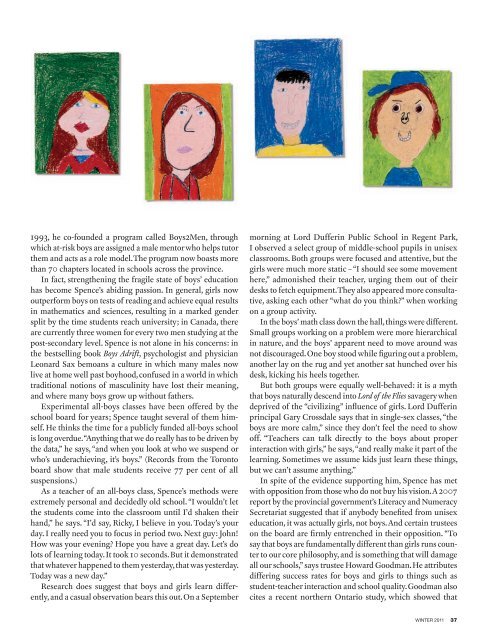The Next Big Idea 10 concepts that could - University of Toronto ...
The Next Big Idea 10 concepts that could - University of Toronto ...
The Next Big Idea 10 concepts that could - University of Toronto ...
Create successful ePaper yourself
Turn your PDF publications into a flip-book with our unique Google optimized e-Paper software.
1993, he co-founded a program called Boys2Men, through<br />
which at-risk boys are assigned a male mentor who helps tutor<br />
them and acts as a role model. <strong>The</strong> program now boasts more<br />
than 70 chapters located in schools across the province.<br />
In fact, strengthening the fragile state <strong>of</strong> boys’ education<br />
has become Spence’s abiding passion. In general, girls now<br />
outperform boys on tests <strong>of</strong> reading and achieve equal results<br />
in mathematics and sciences, resulting in a marked gender<br />
split by the time students reach university; in Canada, there<br />
are currently three women for every two men studying at the<br />
post-secondary level. Spence is not alone in his concerns: in<br />
the bestselling book Boys Adrift, psychologist and physician<br />
Leonard Sax bemoans a culture in which many males now<br />
live at home well past boyhood, confused in a world in which<br />
traditional notions <strong>of</strong> masculinity have lost their meaning,<br />
and where many boys grow up without fathers.<br />
Experimental all-boys classes have been <strong>of</strong>fered by the<br />
school board for years; Spence taught several <strong>of</strong> them himself.<br />
He thinks the time for a publicly funded all-boys school<br />
is long overdue. “Anything <strong>that</strong> we do really has to be driven by<br />
the data,” he says, “and when you look at who we suspend or<br />
who’s underachieving, it’s boys.” (Records from the <strong>Toronto</strong><br />
board show <strong>that</strong> male students receive 77 per cent <strong>of</strong> all<br />
suspensions.)<br />
As a teacher <strong>of</strong> an all-boys class, Spence’s methods were<br />
extremely personal and decidedly old school. “I wouldn’t let<br />
the students come into the classroom until I’d shaken their<br />
hand,” he says. “I’d say, Ricky, I believe in you. Today’s your<br />
day. I really need you to focus in period two. <strong>Next</strong> guy: John!<br />
How was your evening Hope you have a great day. Let’s do<br />
lots <strong>of</strong> learning today. It took <strong>10</strong> seconds. But it demonstrated<br />
<strong>that</strong> whatever happened to them yesterday, <strong>that</strong> was yesterday.<br />
Today was a new day.”<br />
Research does suggest <strong>that</strong> boys and girls learn differently,<br />
and a casual observation bears this out. On a September<br />
morning at Lord Dufferin Public School in Regent Park,<br />
I observed a select group <strong>of</strong> middle-school pupils in unisex<br />
classrooms. Both groups were focused and attentive, but the<br />
girls were much more static – “I should see some movement<br />
here,” admonished their teacher, urging them out <strong>of</strong> their<br />
desks to fetch equipment. <strong>The</strong>y also appeared more consultative,<br />
asking each other “what do you think” when working<br />
on a group activity.<br />
In the boys’ math class down the hall, things were different.<br />
Small groups working on a problem were more hierarchical<br />
in nature, and the boys’ apparent need to move around was<br />
not discouraged. One boy stood while figuring out a problem,<br />
another lay on the rug and yet another sat hunched over his<br />
desk, kicking his heels together.<br />
But both groups were equally well-behaved: it is a myth<br />
<strong>that</strong> boys naturally descend into Lord <strong>of</strong> the Flies savagery when<br />
deprived <strong>of</strong> the “civilizing” influence <strong>of</strong> girls. Lord Dufferin<br />
principal Gary Crossdale says <strong>that</strong> in single-sex classes, “the<br />
boys are more calm,” since they don’t feel the need to show<br />
<strong>of</strong>f. “Teachers can talk directly to the boys about proper<br />
interaction with girls,” he says, “and really make it part <strong>of</strong> the<br />
learning. Sometimes we assume kids just learn these things,<br />
but we can’t assume anything.”<br />
In spite <strong>of</strong> the evidence supporting him, Spence has met<br />
with opposition from those who do not buy his vision. A 2007<br />
report by the provincial government’s Literacy and Numeracy<br />
Secretariat suggested <strong>that</strong> if anybody benefited from unisex<br />
education, it was actually girls, not boys. And certain trustees<br />
on the board are firmly entrenched in their opposition. “To<br />
say <strong>that</strong> boys are fundamentally different than girls runs counter<br />
to our core philosophy, and is something <strong>that</strong> will damage<br />
all our schools,” says trustee Howard Goodman. He attributes<br />
differing success rates for boys and girls to things such as<br />
student-teacher interaction and school quality. Goodman also<br />
cites a recent northern Ontario study, which showed <strong>that</strong><br />
winter 2011 37
















